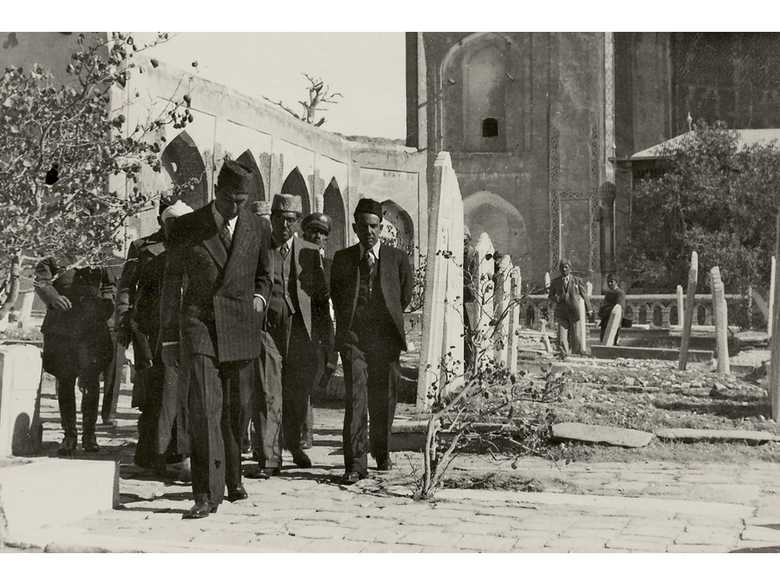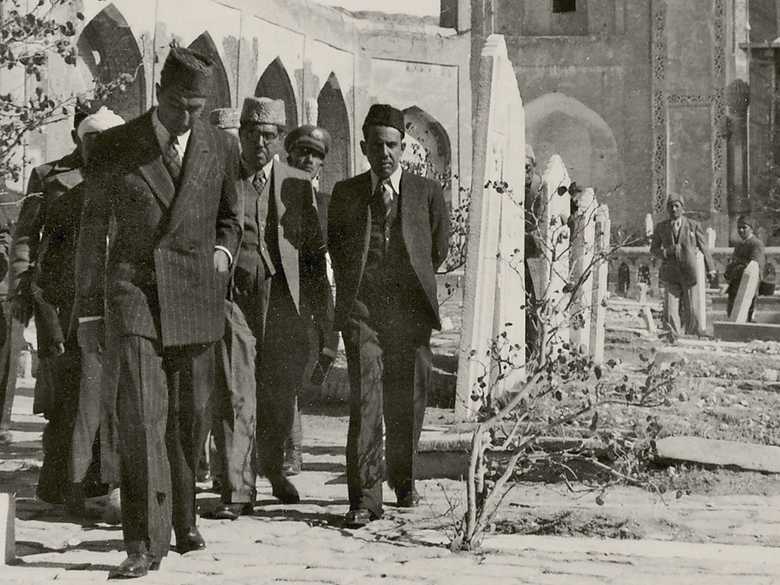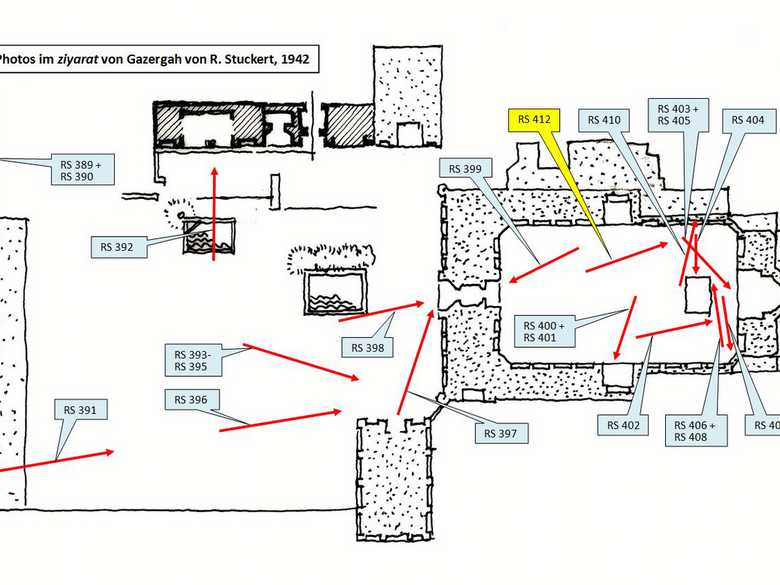RS 412 — Besuch des Gouverneurs Abdullah Malikyar in Gazergah
|RS 412-1| Eine Gruppe hochgestellter Afghanen in europäischer Kleidung im Innenhof des ziyarats. Diese Aufnahme zeigt einen Besuch des Gouverneurs Abdullah Malikyar in Gazergah.
|RS 412-2| Ausschnitts-Vergrösserung von RS 412-1: Gouverneur, Bürgermeister und Polizeikommandant von Herat bei einem Besuch in Gazergah.
|RS 412-1|
Eine Gruppe hochgestellter Afghanen in europäischer Kleidung im Innenhof des ziyarats. Diese Aufnahme zeigt einen Besuch des Gouverneurs Abdullah Malikyar in Gazergah.
- R. Stuckert (1994): Erinnerungen an Afghanistan, S. 62: „Anfang Januar [1943] fahren wir nach Gazar-Gah und weiter hinauf ins Tal zu den Steinbrüchen. […]“
- L. Golombek (1969): The Timurid Shrine at Gazur Gah, S. 28: “The Shrine of Gazur Gah is not only a memorial to the patron-saint of Herat. It is one of the richest graveyards in the East. Touching one another, stones of every size and colour mark the tombs of a varied populace, having in common but veneration for the saint and a desire to be buried near him. These are the tombs of princes and dervishes, officials of state and theologians, soldiers, poets, wealthy landowners and destitute beggars.”
S. 29: “On the north the tombstones part to allow the passage of a paved road leading to the cluster of trees surrounding the tomb of Ansari. […]” - L. W. Adamec (1975): Who’s who, S. 46: Malikyar, Abdullah.
- D. Brandenburg (1977): Herat, S. 42–43: „Dieser zweite Hof ist im Grunde genommen ein Friedhof, mit zahlreichen alten, bis in das 8. Jahrhundert d. H. (= 14. Jahrhundert) zurückreichenden, meist schön skulptierten Grabsteinen. Auch in die linksseitige Mauer sind kleine Grabkuppeln eingebaut. Wohl ausschliesslich notable Persönlichkeiten haben hier, im Lauf einiger Jahrhunderte, ihre letzte Ruhestätte gefunden. Es war zu allen Zeiten eine islamische Gepflogenheit, Friedhöfe im Schatten von Heiligengräbern, gewissermassen auf dem kürzesten Wege zum Himmel, anzulegen! […]“
- R. Stuckert (1980): Die Grosse Moschee und das Mausoleum des Ghiyât ud-Dîn in Herat, in: Afghanistan Journal 7/1, S. 3: „Im Gefolge des damaligen Gouverneurs Abdullah Malikiar reisten im Herbst 1942 mein Chef, Bauingenieur Martin Schroeter, und ich als junger Architekt im afghanischen Arbeitsministerium nach Herat. […] Ich hatte als Stadtarchitekt verschiedene Bauaufgaben zu planen. […]“
- T. Allen (1981): A Catalogue of the Toponyms and Monuments of Timurid Herat, S. 67 und S. 177: “Ansari (396-481) was a famous Hanbali scholar, who became Shaykh al-Islam in Herat, and was buried at Gazurgah. […] Shah Rukh erected the present building in 829-30. Sultan Husayn gathered the relics of his ancestors and buried them on a platform (suffah) in the courtyard of the building in 882. Damaged by flood in 898, the hazirah was repaired by 'Ali Shir in 904. The following year Amir Shuja' al-Din Muhammad Barlas made a valuable group of properties vaqf for the shrine; his donation is recorded on a stone slab set into the entry portal of the building. […]”
- R. Samizay (1981): Islamic Architecture in Herat, S. 69–72: “The Ansari shrine is a rectangular building laid out around an interior courtyard. […] The northern side of the court is defined by continuous arch forms - a large ivan in the middle with four arched bays on each side. Each arch has one room or two layers of rooms behind. These back rooms […] have had painted decorations with parts still existing. […]”
Image No.
RS 412
Collection
Rudolf Stuckert 1940-1946
Series
RS 387-412, Herat, Gazergah
Format
Originalabzug 67/109 mm
Quality
sehr gut
Place, date
Herat, Januar 1943
Descriptors
Latitude / Longitude34.374880 / 62.240860
Google Mapshttps://maps.google.com
Zoom Earthhttps://zoom.earth
You know more about this picture?




